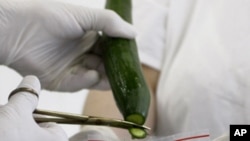As a major outbreak of a highly toxic strain of E. coli bacteria continues to sicken residents of Europe, medical experts are racing to find the source.
E. coli has become a growing public health problem in recent years. The bacteria doesn't usually cause any trouble, says University of Minnesota microbiology professor Michael Sadowski. "E. coli is a normal inhabitant of the intestinal tract of warm-blooded animals."
That means you, me, our livestock and even wild animals are all carrying strains of E. coli around in our guts. The types that cause disease are rare, Sadowski says.
"The majority of E. coli are in fact considered to be harmless. And they carry out various biochemical processes in your intestine and they help you digest food."
|
E. coli and how it is transmitted E. coli is an abbreviation for Escherichia, which is a large and diverse group of bacteria. Most strains are harmless, others can cause illness. Symptoms include stomach cramps, diarrhea and vomiting. The major source is cattle, but other animals, foods and liquids may spread contamination to people.
|
And the majority have remained relatively harmless until fairly recently, says University of Minnesota food safety professor Francisco Diez. "We didn't have this type of organism before 1982."
That's when the first deadly strain of E. coli appeared in hamburger meat in the United States. Before then, Diez says, E. coli wasn't even considered a disease-causing germ.
According to Diez, it is not clear exactly how this new virulence developed. It may have been changes in the bacteria, or changes in the way food is produced or distributed. Whatever the cause, E. coli is now turning up in a growing number of fruits and vegetables including apples, lettuce, and spinach.
For a germ that was first found in meat, it seems like a long way to the produce aisle. But Diez says there is a connection.
"We've seen an increase in cases of produce-associated outbreaks, but ultimately the source is cattle."
He says cattle-manure fertilizer that has not been well composted may still carry live bacteria from the animals’ gut. Or manure may contaminate irrigation water. It could also be on the hands of someone picking or sorting the produce. Add storage, transportation, and preparation as other places between the farm and the fork where food can become contaminated with the bacteria.
That's part of why tracing an outbreak to its source is so difficult. In Europe, officials originally blamed Spanish-grown cucumbers, but now they are not so sure. Other suspects include tomatoes and lettuce.
The problem is, those are all common salad ingredients.
"It's hard to find enough people that only ate one, and only ate one once in the time period before their infection," says Christopher Braden, head of the foodborne disease section at the U.S. Centers for Disease Control and Prevention." They're commonly eaten. They're commonly eaten together. So to try to tease one apart as to which one is the culprit can be difficult."
Spain maintains that its cucumbers have been falsely accused. Spanish farmers are losing huge amounts of money, and they are furious.
The CDC was in a similar position in 2008 when it blamed tomatoes for a salmonella outbreak that ultimately was pinned on peppers.
Braden says it can be a hard decision to make when you have preliminary information that points to a suspect. "And in the meantime, people are getting ill and possibly dying in large numbers. Sometimes there's a real balancing act between being fast and being right. Often times it's really hard to do both."
He adds that, if their first suspicions proved correct, they could also be criticized if they did not act.
There are still a lot of unknowns about the current European outbreak, and it will likely be some time before they are all resolved.
In the meantime, the advice remains the same: wash your hands after using the toilet, and before preparing food and eating, and wash counters and utensils that come in contact with raw meat.
And if you are concerned about the cleanliness of raw vegetables, cook them well.












